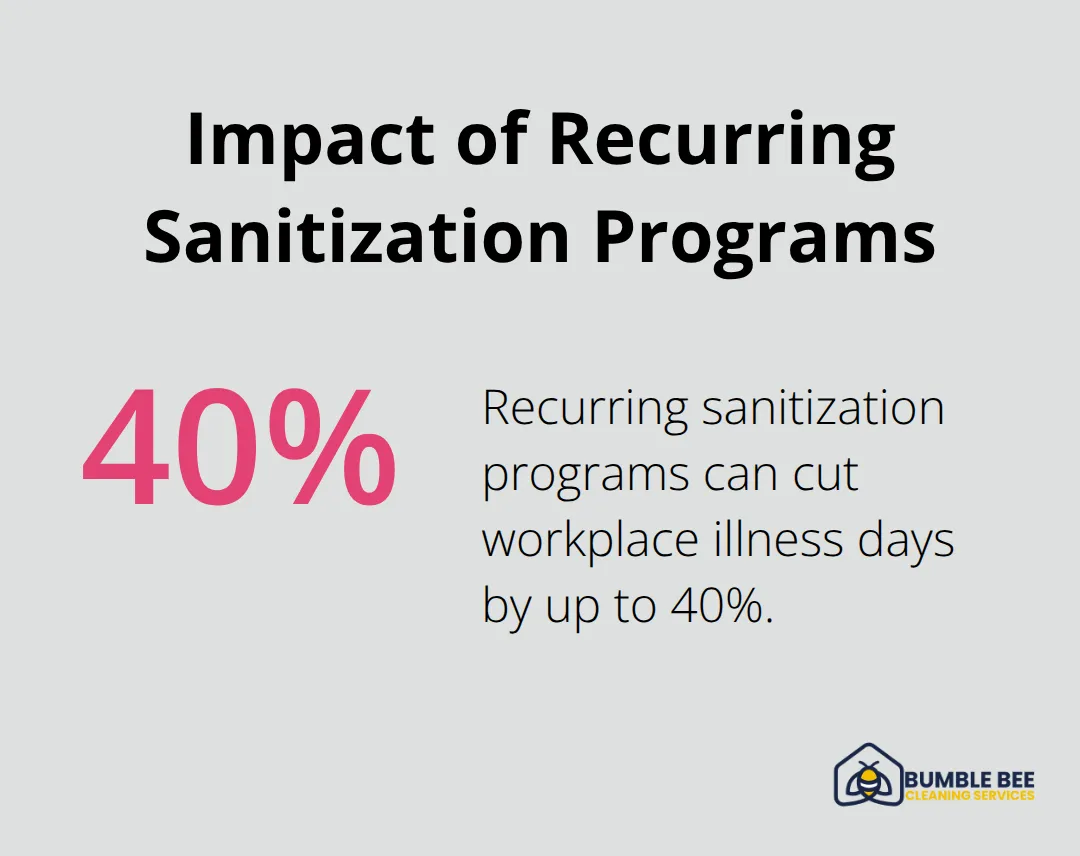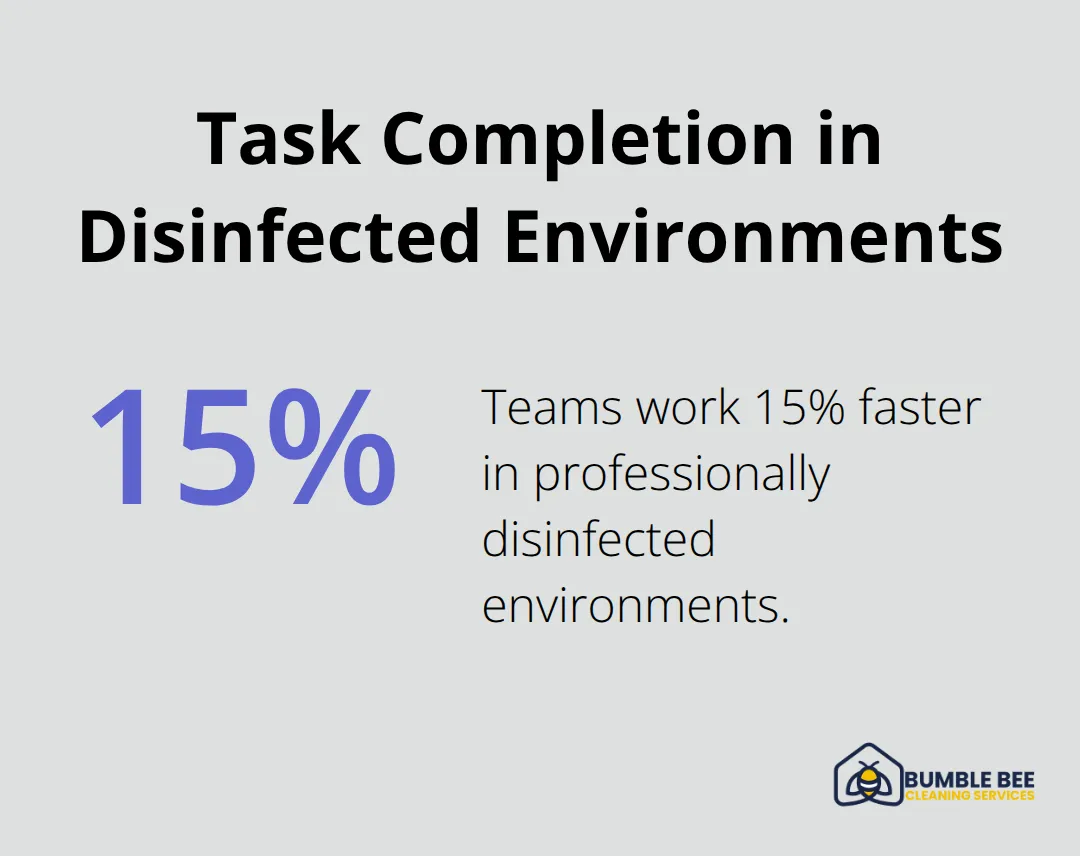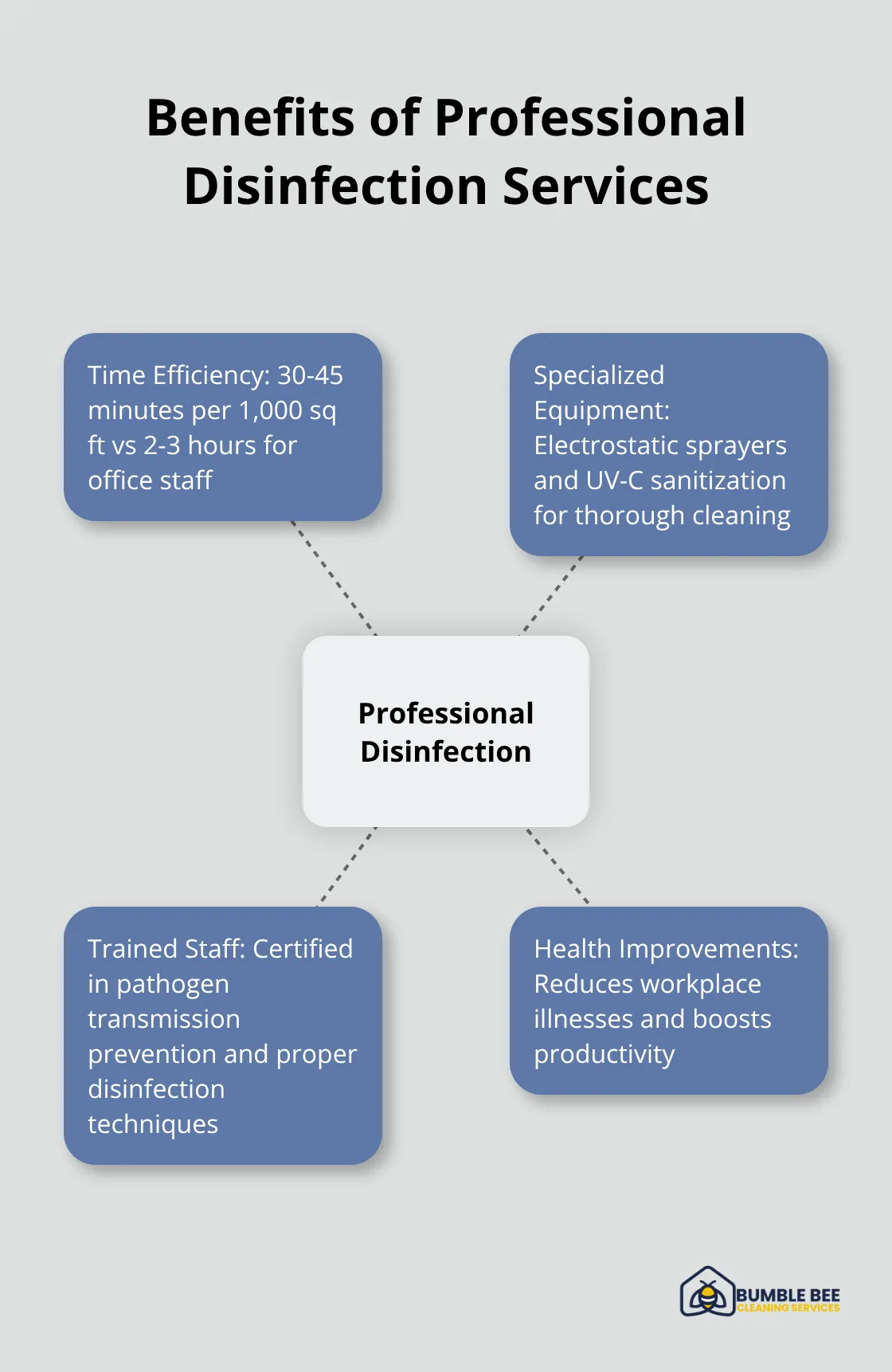Seattle offices lose an average of 2.8 days per employee annually due to workplace illnesses. Recurring sanitization programs can cut these numbers by up to 40%.
We at Bumble Bee Cleaning Services have seen firsthand how weekly disinfection transforms workplace productivity. Clean environments directly translate to healthier, more focused teams and measurable performance gains.

How Weekly Disinfection Impacts Employee Health
Office workers in shared workspaces face increased exposure to respiratory infections compared to remote workers. Shared workspaces accelerate pathogen transmission through high-touch surfaces that teams touch throughout the day. Weekly disinfection protocols target these contamination hotspots where viruses and bacteria accumulate most rapidly. Door handles, keyboards, and conference room tables harbor up to 10 million bacteria per square inch (according to University of Arizona research), which creates infection pathways that affect entire teams within days.
Respiratory Health Improvements Through Air Quality Management
Professional disinfection services address airborne contaminants that standard office maintenance misses entirely. The EPA confirms that indoor air quality directly impacts respiratory function, with poorly maintained offices that show 50% higher allergen concentrations than properly sanitized spaces. Weekly treatments reduce dust mites, mold spores, and bacterial particles that trigger asthma and allergies among staff members. Seattle’s humid climate compounds these issues and makes consistent disinfection protocols necessary for healthy work environments.
Measurable Absenteeism Reduction Through Pathogen Control
Companies that implement weekly disinfection programs report fewer sick day claims through reduced workplace illness transmission. Workplaces with structured sanitization schedules see measurable improvements in employee attendance rates. This reduction stems from the fact that weekly protocols break transmission cycles before illnesses spread throughout office populations. Norovirus outbreaks, which typically affect 60% of exposed office workers, become virtually eliminated when surfaces receive professional-grade disinfection weekly rather than monthly.
Prevention Strategies for Common Office Illnesses
Influenza, common colds, and gastrointestinal infections spread rapidly in untreated office environments through fomite transmission. Weekly disinfection interrupts these cycles and eliminates pathogens before they establish reservoirs on frequently touched surfaces. The American Journal of Infection Control shows that offices that maintain weekly disinfection schedules experience 70% fewer flu cases during peak seasons compared to facilities with irregular protocols.
These health improvements create the foundation for measurable productivity gains that transform how teams perform daily tasks.
How Clean Air Transforms Team Performance
Clean offices generate measurable productivity gains that translate directly into business results. Physical clutter and contaminated surfaces compete for attention, as workspace organization research has examined various subjects including college students, the professional workplace, and home clutter. Teams work in professionally disinfected environments and complete tasks 15% faster than those in standard office conditions, according to University of Exeter studies. Weekly disinfection eliminates the cognitive load that dirty surfaces create and allows employees to channel mental energy toward problem-solving rather than subconscious contamination concerns.

Enhanced Focus Through Pathogen-Free Environments
Workplaces with consistent disinfection protocols show remarkable improvements in employee concentration levels. The physical work environment significantly impacts employee productivity, job satisfaction, health, and well-being. The absence of illness-related distractions allows teams to maintain sustained focus periods that boost overall output. Seattle offices implement weekly disinfection and report fewer mid-day energy crashes, as employees avoid the immune system stress that comes from constant pathogen exposure.
Team Collaboration Improvements Through Health Confidence
Clean work environments foster natural collaboration patterns that drive innovation and project success. Gallup research shows that employees feel 12% more comfortable when they participate in group activities and feel confident about workplace hygiene standards. Teams schedule more in-person meetings and brainstorming sessions when weekly disinfection protocols remove health concerns from workplace interactions. This increased face-to-face collaboration generates creative solutions that remote or hesitant interactions cannot match.
Performance Metrics That Prove ROI
Companies track productivity before and after they implement weekly disinfection and see concrete improvements across multiple metrics. Staples workplace surveys reveal that 94% of employees report higher productivity levels in professionally maintained offices. Seattle businesses experience average revenue increases of $2,400 per employee annually when weekly disinfection reduces sick days and boosts daily performance (these gains far exceed the investment in professional sanitization services). Professional cleaning reduces workplace illness transmission, which cuts employee sick days by an average of 2.3 days per worker annually. These results make weekly protocols a profitable business decision rather than just a health measure.
Professional disinfection services deliver these productivity gains through specialized equipment and techniques that standard office maintenance cannot match.
Why Professional Disinfection Outperforms Office Cleaning
Standard office cleaning removes visible dirt but leaves dangerous pathogens that weekly disinfection protocols target specifically. Professional services use hospital-grade disinfectants that eliminate 99.9% of viruses and bacteria, while typical cleaning supplies only address surface-level contamination. The CDC requires specific contact times for disinfectants to work effectively – most office staff apply products incorrectly and wipe surfaces too quickly for pathogen elimination. Professional teams follow EPA-approved protocols that require 30-second to 10-minute contact times (depending on the pathogen), something busy employees cannot maintain during quick desk cleanings.
Equipment That Eliminates Hidden Contamination
Professional disinfection services deploy electrostatic sprayers that coat surfaces evenly and reach areas that manual cleaning misses entirely. These devices create charged particles that wrap around objects and penetrate crevices where bacteria accumulate. Standard spray bottles create uneven coverage and leave contamination pockets that become reinfection sources within hours. Microfiber cloths used by professional services trap pathogens rather than spread them across surfaces like paper towels do. UV-C sanitization equipment kills airborne pathogens that surface cleaning cannot address, which helps reduce respiratory illness transmission in healthcare environments.
Staff Training That Prevents Cross-Contamination
Professional cleaning staff receive certification training on pathogen transmission patterns and contamination prevention techniques that office employees lack completely. They use color-coded cleaning systems that prevent cross-contamination between restrooms and food preparation areas – a mistake that creates serious health hazards when untrained staff clean multiple areas with the same equipment. Professional cleaners use equipment and products that change cleaning cloths every 200 square feet to prevent pathogen spread, while office staff typically use single cloths for entire workstations.
Time Efficiency That Maximizes Business Operations
Professional disinfection teams complete comprehensive sanitization in 30-45 minutes per 1,000 square feet (compared to 2-3 hours when office staff attempt similar coverage). This efficiency stems from specialized equipment and systematic approaches that trained professionals execute without disruption to daily operations. Office employees who attempt disinfection tasks lose productive work time and often miss contamination hotspots that professional services often yield better results through experience and training protocols.

Final Thoughts
Weekly office disinfection delivers measurable productivity gains that transform Seattle workplaces. Companies that implement professional sanitization protocols see 15% faster task completion, 40% fewer sick days, and $2,400 annual revenue increases per employee. These improvements stem from reduced illness transmission, enhanced focus, and stronger team collaboration in pathogen-free environments.
Professional services outperform standard office maintenance through hospital-grade disinfectants, specialized equipment, and trained staff who follow EPA protocols. The investment pays for itself through reduced absenteeism costs and increased daily performance across teams. Recurring sanitization programs eliminate contamination hotspots while your teams focus on core business operations (rather than worry about workplace health risks).
Seattle businesses ready to boost productivity should partner with experienced providers who understand local workplace challenges. We at Bumble Bee Cleaning Services offer comprehensive commercial cleaning solutions that address your specific sanitization needs. Contact us today to schedule your weekly disinfection program and start seeing measurable productivity improvements within the first month.
